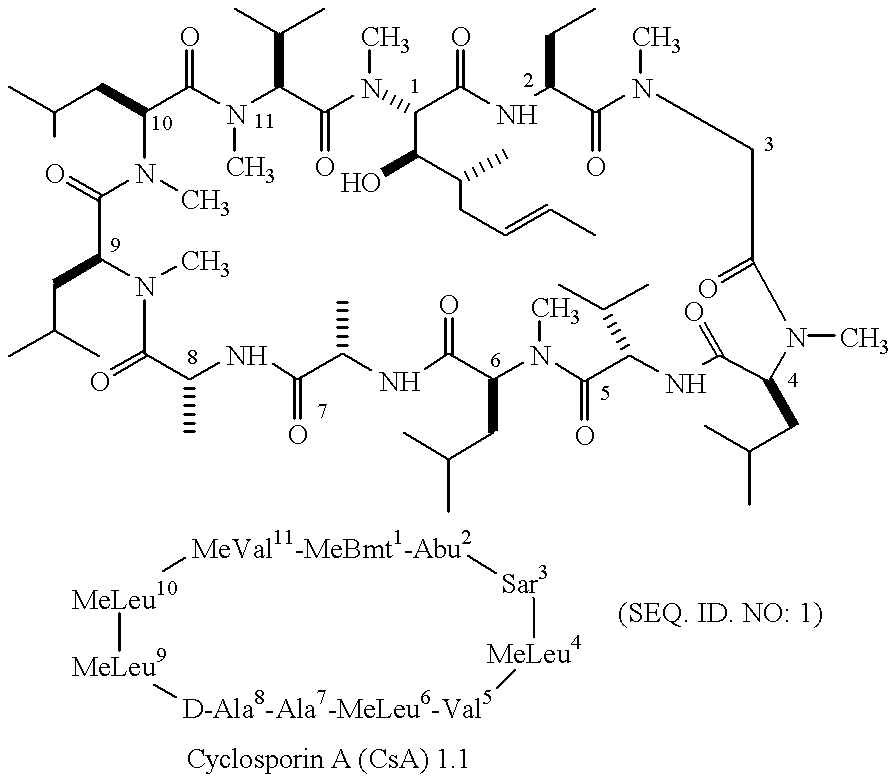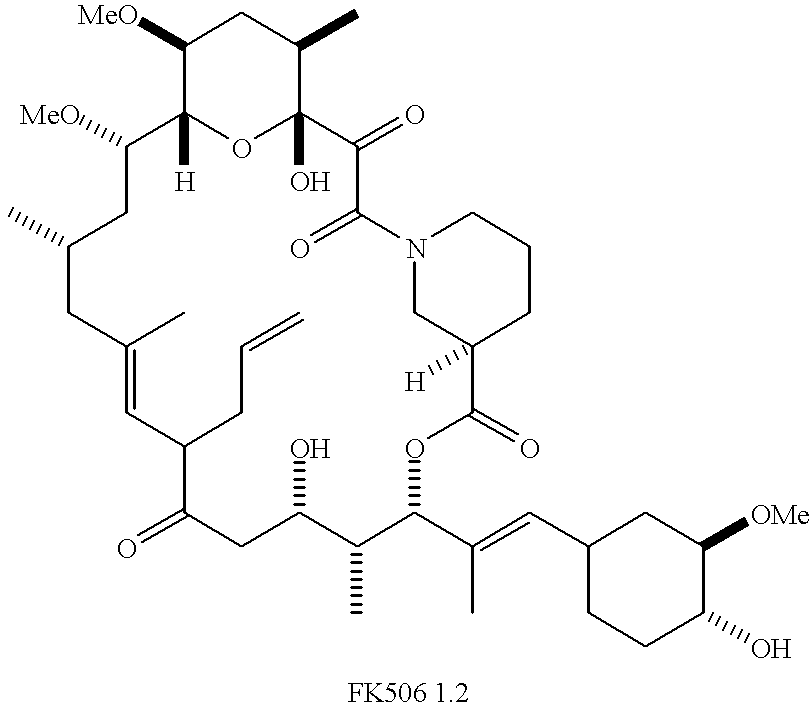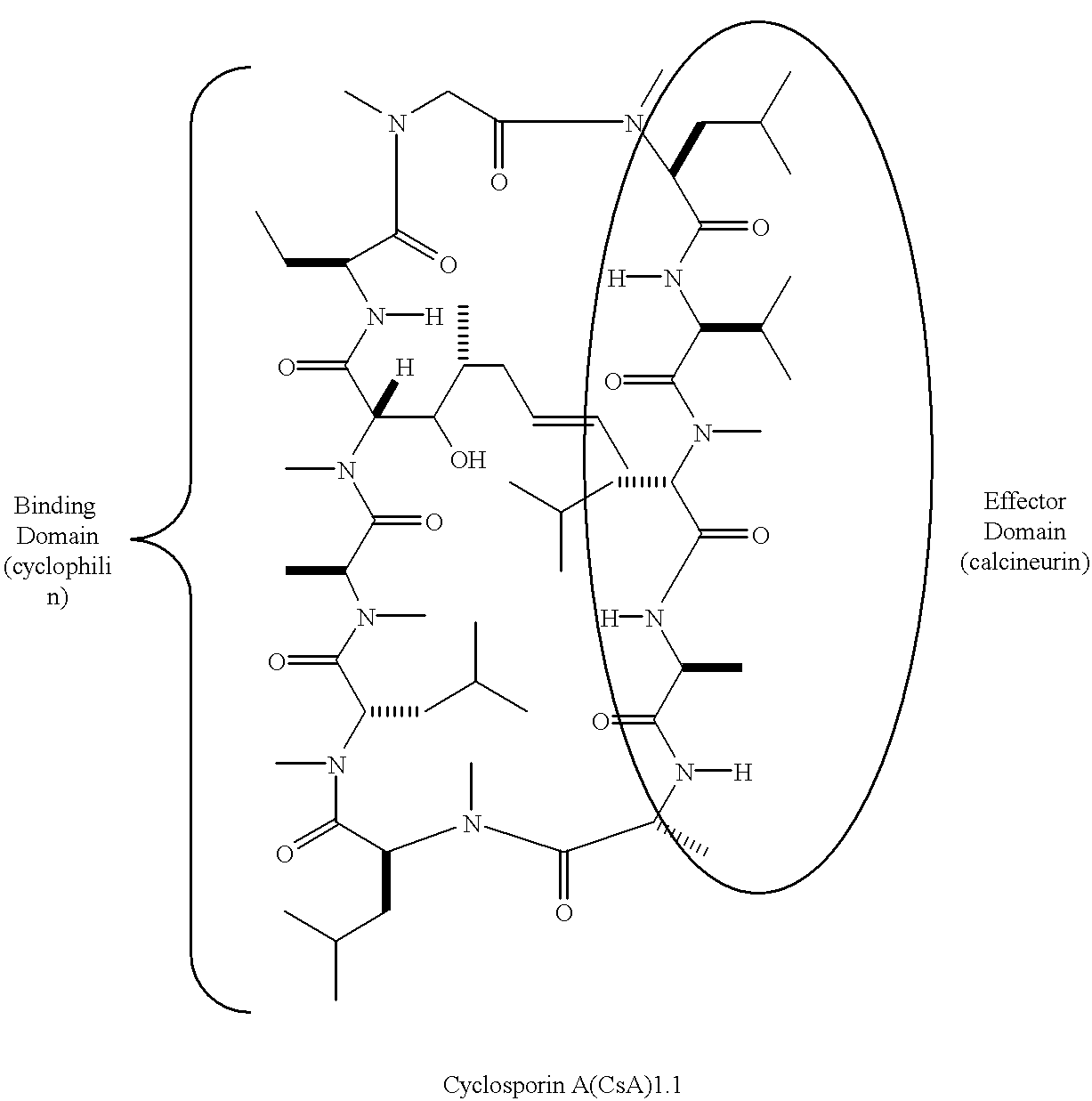Cyclosporin a conjugates and uses therefor
a technology of cyclosporin and conjugates, which is applied in the field of cyclosporin conjugates and uses therefor, can solve the problems of inability to use cyclosporin analogs in human gene therapy platforms, inability to inhibit compounds in immunosuppressive drugs, and simple and unambitious designation of cyclosporin analogs, so as to achieve synergistic effect, prevent or ameliorate adverse effects of amyloid plaque formation, and high effect of effective treatment or prevention
- Summary
- Abstract
- Description
- Claims
- Application Information
AI Technical Summary
Benefits of technology
Problems solved by technology
Method used
Image
Examples
example 1
Synthesis of 2S,3R McLeu(3-OH)
Route 1: Syn-(4S,2'S,3'R)-3-(4'-methyl-3'-hydroxy-2'-bromo-1'-pen tanoyl)-4-benzyl-2-oxazolidinone 3.8:
A solution of (4S)-3-bromoacetylphenyl-4-phenyl-2-oxazolidinone 3.7 (1.7 g. 5.7 mmol) in ether (28 ml) was cooled to -78.degree. C., and treated with TEA (1.11 ml, 7.98 mmol), followed by di-n-butylboron trillate (1.73 ml, 6.04 mmol). The cooling bath was removed and the reaction was stirred at room temperature for 1.5 hours. After cooling the reaction back to -78.degree. C. with vigorous stirring, isobutyrlaldehyde (0.545 ml, 5.91 mmol) was added and the resulting reaction mixture was stirred at -78.degree. C. for 0.5 hours and at 0.degree. C. for 2 hours. The reaction was diluted with ether (50 ml), washed with KHSO.sub.4 (2.times.), and concentrated in vacuo. The residue was brought up in 1:1 MeOH / H.sub.2 O (20 ml), cooled to 0.degree. C., followed by addition of 30% H.sub.2 O.sub.2 (7 ml). After stirring the reaction for 1 hour at 0.degree. C., it ...
example 2
Synthesis of CsA Analogs
Boc-MeLeu-Lys(2Cl-Cbz)-OBn 4.1:
Following generalprocedure A, the title compound was synthesized in 80% yield by coupling of the HCl salt of H-Lys(2Cl-Cbz)-OBn (8.56 g, 19.4 mmol) to Boc-MeLeu-OH (5.24 g, 21.3 mmol) in DCM (130 ml) with BOP-Cl (5.43 g, 21.3 mmol) and DIEA (10.5 ml, 60.1 mmol) to give 9.78 g of the dipeptide. R.sub.f =0.29 (30% EthOAc / hexane), [.alpha.].sub.D.sup.23 =-53.01 (c 0.415, CHCl.sub.3), FABMS C.sub.33 H.sub.46 N.sub.3 O.sub.7 Cl) found 632.1.
Boc-Val-MeLeu-Lys(2Cl-Cbz)-OBn 4.2:
Following general procedure D, the Boc group in Boc-MeLeu-Lys(2Cl-Cbz)-OBn 4.1 (9.78 g, 15.5 mmol) was cleaved to form the HCl salt of MeLeu-Lys(2Cl-Cbz)-OBn, which was coupled to Boc-Val-OH (3.7 g, 17.0 mmol) in DCM (105 ml) with BOP-Cl (4.33 g, 17.0 mmol) and DIEA (8.35 ml, 48.0 mmol) via general procedure B to give 6.68 g (59% yield) of the title compound. R.sub.f =0.30 (40% EthOAc / hexane), [.alpha..sub.D.sup.23 =-59.30 (c 0.860, CHCl.sub.3), FABMS (C.sub.36 H...
example 3
Synthesis of FKBP Inhibitors
3-Phenyl-1-(3-hydroxyphenyl)-propanol 11.10:
A solution of 3-hydroxybenzaldehyde (4.5 g, 37 mmol) in THF (50 ml) was treated with 2-phenethylmagnesium chloride (1.0 M in THF, 77.5 ml, 77.5 mmol) at -78.degree. C. under argon. The reaction was stirred for 4 hours at -78.degree. C., diluted with EthOAc (50 ml) and quenched with 1 N HCl (150 ml). The phases were separated and the organic phase was dried over Na.sub.2 SO.sub.4, filtered, and concentrated in vacuo. The white solid was recrystallized from 20% EthOAc / hexane to give 6.02 g (72% yield) of the title compound 11.10. R.sub.f =0.24 (30% EthOAc / hexane). .sup.1 H NMR (300 MHz, CDCl.sub.3) .delta. 7.23-7.15 (m, 6H), 6.93-6.84 (m, 2H), 6.79-6.71 (m, 1H), 4.95 (br s, 1H), 4.65 (t, 1H, J=5.6 Hz), 2.81-260 (m, 2H), 2.19-1.95 (m, 2H), 1.89 (br s, 1H).
3-Phenyl-1-(3-hydroxyphenyl)-propan-1-one 11.11:
A solution of alcohol 11.10 (4 g, 17.5 mmol) in acetone (40 ml) was treated with Jones Reagent at room temperature...
PUM
| Property | Measurement | Unit |
|---|---|---|
| dissociation constant | aaaaa | aaaaa |
| mass | aaaaa | aaaaa |
| temperature | aaaaa | aaaaa |
Abstract
Description
Claims
Application Information
 Login to View More
Login to View More - R&D
- Intellectual Property
- Life Sciences
- Materials
- Tech Scout
- Unparalleled Data Quality
- Higher Quality Content
- 60% Fewer Hallucinations
Browse by: Latest US Patents, China's latest patents, Technical Efficacy Thesaurus, Application Domain, Technology Topic, Popular Technical Reports.
© 2025 PatSnap. All rights reserved.Legal|Privacy policy|Modern Slavery Act Transparency Statement|Sitemap|About US| Contact US: help@patsnap.com



